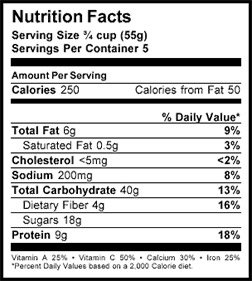
How Accurate Are Calorie Counts?
You can look at almost any food label and quickly find the Calorie content, but do you know how food scientists determine this number, or how accurate it is? Learn the simple science behind measuring the energy in your food!
Whether you're a keen shopper, a health-conscious parent, or an athlete training for a specific fitness goal, chances are you've looked at a food label or two, right? You probably check the total Calories per serving of many foods you eat, taking comfort when you make clean choices. But have you ever wondered how the caloric value of your food is determined?
If this question has crossed your mind, perhaps you've gone a little deeper down the rabbit hole and wondered why 1 gram of carbohydrate and 1 gram of protein both equal 4 Calories, but 1 gram of fat equals 9 Calories. Even more puzzling is how the heck they squeeze 100 Calories into those 100-Calorie snack packs!
How the energy in your food is determined may seem like one of life's great mysteries, but there's actually a simple method behind it all! To understand how that energy is calculated, it helps to first define a calorie.
A calorie is simply a measurement of energy. Specifically, it's the amount of energy needed to raise 1 gram of water 1 degree Celsius. However, that's not what you actually see on food labels. The Calorie—note the capital C—you see on a food label is actually a kilocalorie (kcal), or 1,000 calories, which is the amount of energy needed to raise 1 kilogram of water 1 degree Celsius. No, you don't need to start counting your calories and multiplying by 1,000. This information is really just to clarify the science and the different versions and meanings of the word. Just keep in mind that, when talking about food, we're talking about Calories, or kilocalories.
Dropping the Calorie Bomb
So how are the Calories of your favorite foods determined? The original method, called bomb calorimetry, involved placing a food item into a sealed container surrounded by water and literally igniting the food until it completely burned up. The heat given off by the food would subsequently cause a rise in the water temperature. Scientists could then measure the change in water temperature to calculate how many Calories were in the food. From this method, the following values were calculated for the macronutrients:
- Carbohydrate: 4.2 kcals
- Fat: 9.4 kcals
- Protein: 5.7 kcals
This is slightly higher than what you see on packages, right? That's because bomb calorimetry provides an accurate measure of the total calorie content of food, but it slightly overcalculates the actual amount of useable energy, since the absorption and digestion rates of nutrients vary in actual human beings.

What you see on a food label—4 kilocalories for carbs, 4 kilocalories for protein, and 9 kilocalories for fat—are indirect calorie estimations made using the Atwater system, a conversion system named after its creator, Dr. Wilbur Olin Atwater.
This method takes into account the gross energy value, apparent digestibility coefficient, and urinary correction of a food source to provide the most accurate measure of macronutrients that exists to date. For example, dietary fiber reduces the percent of the food that is useable by the body for energy production, so the fiber component is usually subtracted from the total carbohydrates before calculating calories. This is why we're familiar with 4 kilocalories per 1 gram of carbohydrate, rather than 4.2 kilocalories. There are some limitations to this method and slight variations in the actual content of foods, but overall, it gives pretty accurate values.
Are Food Labels Accurate?
Now that you know how Calories in your favorite foods are determined, the next step is to ask: Are the labels on those foods accurate?

A study published in The Journal of the American Medical Association showed that the actual caloric content in packaged foods differed by as much as 25 percent from what was on the label.1 To add to that, a study out of Tufts University in Boston, Massachusetts, investigated the food-label accuracy of restaurant foods and frozen meals. Researchers reported that some restaurant foods contained up to two times the stated calories, and the average calorie content of frozen meals was 8 percent higher than what was on the label.2
More recently, a report from the National Institute of Health demonstrated that the caloric content in the most commonly consumed energy-dense snack foods in the U.S. is overall slightly higher than stated on the nutrition label.3
The Bottom Line
Although these studies found some food labels to be inaccurate, the discrepancies are often relatively small and should not be a major concern. However, if you're concerned about the accuracy of food labels, weigh out your food (in grams or ounces) rather than using the approximate serving sizes on labels, and be consistent in your tracking. Even if the numbers are slightly off, as long as you track your calories consistently, you can make small changes in the amount you're eating to help you reach your desired weight.
References
- Allison, D. B., Heshka, S., Sepulveda, D., & Heymsfield, S. B. (1993). Counting calories—caveat emptor. JAMA, 270(12), 1454-1456.
- Urban, L. E., Dallal, G. E., Robinson, L. M., Ausman, L. M., Saltzman, E., & Roberts, S. B. (2010). The accuracy of stated energy contents of reduced-energy, commercially prepared foods. Journal of the American Dietetic Association, 110(1), 116-123.
- Jumpertz, R., Venti, C. A., Le, D. S., Michaels, J., Parrington, S., Krakoff, J., & Votruba, S. (2013). Food label accuracy of common snack foods. Obesity, 21(1), 164-169.
